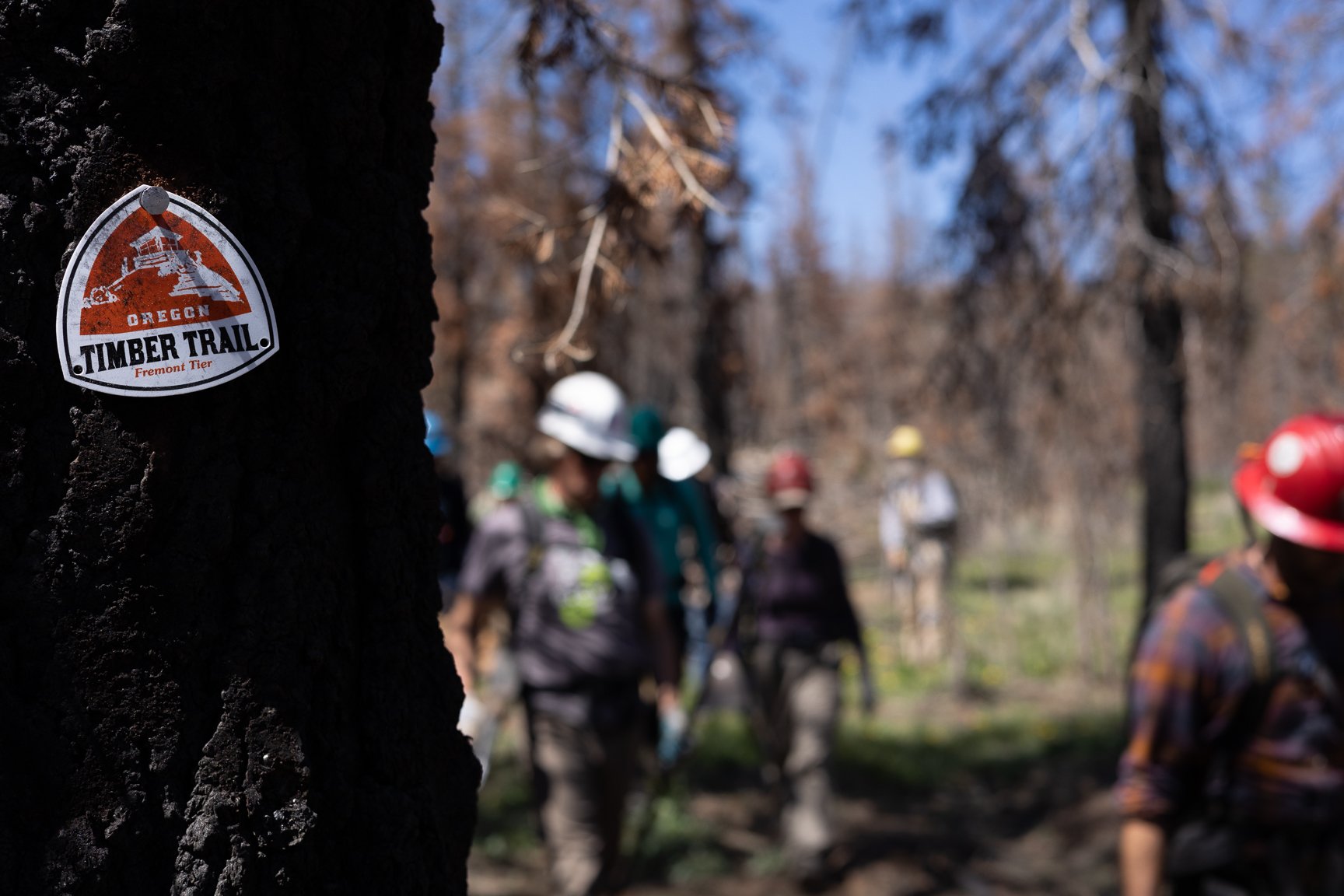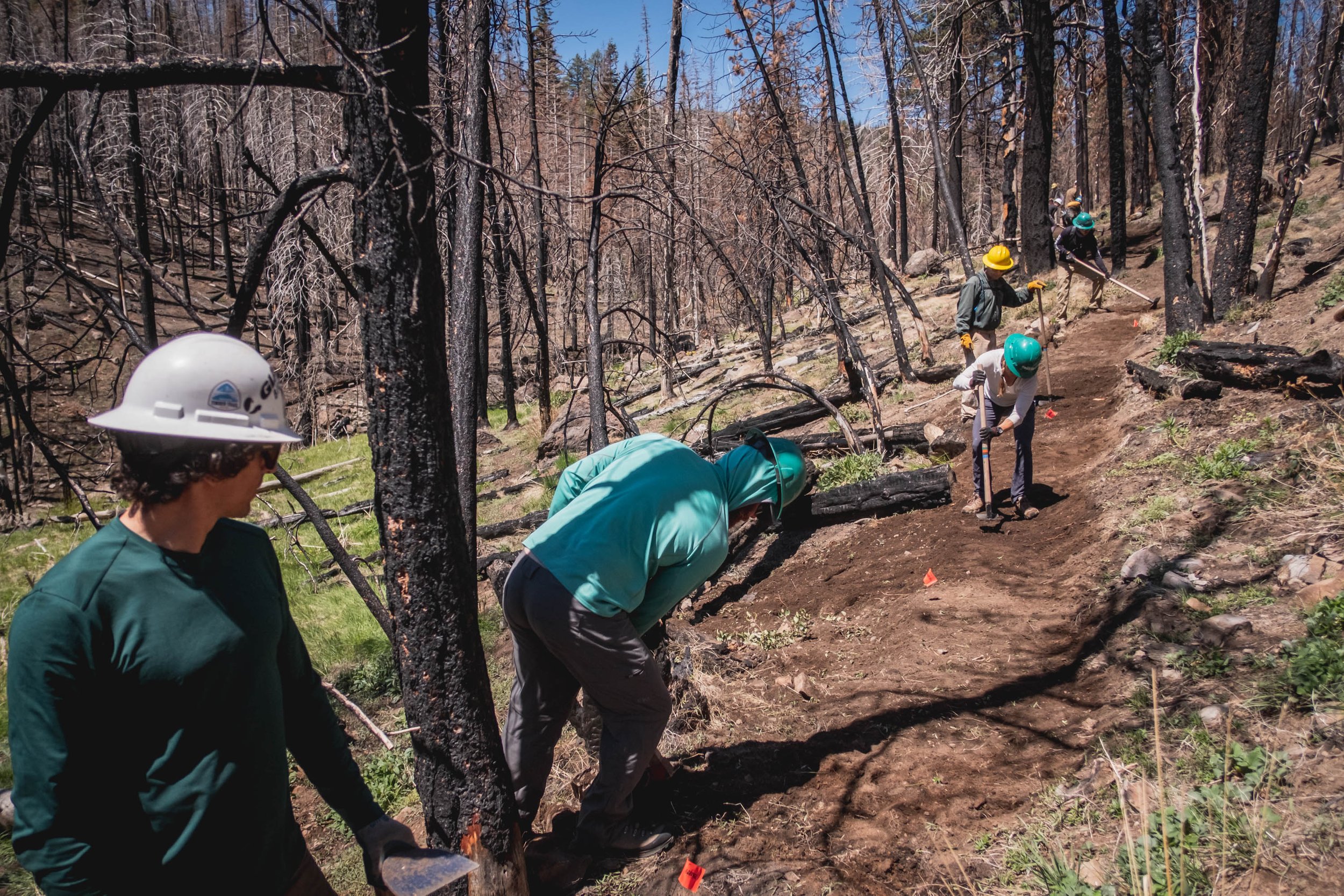This story by Nathan Pipenberg appeared in Mountain Flyer Magazine #70
Newly installed blazes on the Fremont tier of the OTT. Photo:D.Sharp
If anyone can put you at ease as a passenger in a rattling camper van descending overgrown 4x4 roads, it’s Paul Thomasberg. A natural storyteller with a surfer’s drawl, he delivered a highlight reel of his decades-long mountain biking career as he navigated around potholes, through mud, and across gravel washboards.
“One of my strengths as a racer was riding blind lines,” he said. “I was always good at that.” Here, on rough roads in a remote corner of the Fremont-Winema National Forest, his well-honed reaction times were proving useful in getting us to the trailhead in one piece, as well.
Here, on rough roads in a remote corner of the Fremont-Winema National Forest, his well-honed reaction times were proving useful in getting us to the trailhead in one piece, as well.
T-berg in his element. Photo: Gabe Tiller
Thomasberg—mountain bike Hall of Famer, former pro racer, and prolific trail builder—wasn’t the last person I expected to meet when I signed on for a weekend of volunteer trail work, but he was definitely closer to last than first on the list. Volunteerism doesn’t usually mean meeting industry pros and world-class athletes. But I was quickly learning that trail work on the Oregon Timber Trail comes with its own set of rules.
First off, bonus hours are encouraged. Just because you’ve put in a full day’s work clearing trail doesn’t mean someone won’t interrupt you during dinner, explaining that there’s another trail in the area that needs to be logged out, and, no pressure, but we’ve got hours of sunlight to work with and a group of us are heading out now.
Secondly, all you need to bring to the table is enthusiasm and a pair of work gloves.
And finally, chances are the fellow volunteer you’ve just met is a badass in hiding, and is just too humble to mention it until you ask point blank.
Teamwork. Paul and Dana moving heavy rocks for better flow. Photo: D.Sharp
Momentum
New Fremont signage, trail crew hiking in. Photo: D.Sharp
As with firefighting, trail work allows you to compartmentalize. By necessity, my focus soon turned to my thirst, the blisters forming on my palms, and the 100-foot stretch of barely discernible trail I had been charged with perfecting. I focused on the swing of my tool, and each clump of grass I cleaved from the ground.
After just one day of trail work, I realized that my pessimism had been blunted by the strange, addictive momentum that trail work instills. My 100-foot section connected to another, then another, and by the end of the day a trail had been etched into the ground. As we walked back to the vehicles, we talked about the trail we’d be tackling the next day, and how good it would feel to wash away the dirt with a dip in the lake. Beneath a balm of sweat and purpose, the charred landscape faded into the background.
That’s when I realized this story isn’t about wildfire, at least not entirely. The burn scars, the trail closures, the looming spectre of the even worse fire seasons to come—those are all undeniable truths that the American West will be grappling with for years to come. But this story is really about momentum, and how it’s created. It’s momentum that allowed the OTT to be developed in the first place. It’s what motivates volunteers to show up on holiday weekends to dig in the dirt. It’s what makes each hard-earned mile of trail carved into an unforgiving landscape feel like a worthy goal. When the next wildfire comes, it’s momentum that will ensure the trail is here to stay.
Grand Depart 2021. Photo by Conan Thai
Wildfire
In many ways still in its infancy, the OTT and its advocates have navigated the pitfalls of long trail development with grace. Singletrack bikepackers are something of a rare breed, and overuse is a distant problem for now. Spaces in training courses and stewardship events are nabbed in a matter of days, the OTTA consistently meets its goals for volunteer hours. Corporate sponsors like Rapha and the Specialized Soil Searching initiative have stepped up to the plate financially.
But crises come in all shapes and sizes, and by 2020, it was obvious that the OTT’s had arrived on the back of something that couldn’t be planned for or outmaneuvered—Oregon’s most destructive wildfire season in recorded history.
Part of what made last year’s fire season so unprecedented was that the largest and most destructive fires all occurred on the western slopes of the Cascade Range, in forests stretching between Portland and Eugene that are generally fire-resistant. But years of drought conditions, combined with an unusual storm system that whipped up winds out of the east, sent fires racing down forested canyons that hadn’t seen fire in decades. Western Oregon’s moist, temperate climate turned into a tinderbox.
Which way? Photo: Gabe Tiller
For a long time after the fires were extinguished, trails were the last thing on anyone’s mind. The worst of the fires leveled entire towns. Residents were deciding whether to rebuild or move away. Houses that survived the onslaught went without power or water for months.
In the face of so much damage, wondering how the trails fared seems myopic at best. But rebuilding a community means rebuilding the entire community, and eventually recreation factors into the equation…
…There’s plenty of evidence that mountain biking can serve as an economic engine in Oregon. In Oakridge, a town of about 3,000 whose economy was once dominated by the timber industry, recreation is helping to cover the gaps. A 2014 study found that mountain bikers spent between $2.4 to $4.9 million in Oakridge every year, accounting for about five percent of the town’s economy.
Watson Fire rehab tread work, 2021. Photo: D.Sharp
Commitment
To date, that commitment has resulted in more than 10,000 hours of volunteer trail work, with some 3,000 additional hours expected in 2021. An early project was to rehabilitate all 130 miles of the Fremont National Recreation Trail, which makes up much of the OTT’s southern section. In 2018, the Watson Creek Fire burned through about 16 miles of that trail, and the OTTA responded by redoubling its efforts. In 2019, it was awarded a $150,000 grant to once again rehab the trail, in exchange for a commitment of 2,000 volunteer hours.
Kevin Rowell teaching an OTT sawyers class in 2018. Photo: D.Sharp
Beyond the stewardship events, the OTTA has committed to training and attracting new volunteers. A series of courses, most of which quickly filled up or sold out, instructed participants in trail building techniques and bikepacking and navigational skills. Perhaps most impressively, a series of chainsaw courses resulted in the certification of 50 new volunteers allowed to operate saws on National Forest land.
One volunteer I met, Ethan Gefroh, had been introduced to the OTT through one of these courses, a “Backcountry Builder” course the OTT hosted in Oakridge in partnership with the Willamette National Forest.
“I saw it as a chance for both personal and professional development,” Gefroh said, who works as a landscape architect in Eugene. “Trail building seemed like a way to connect my work to my love of mountain biking.”
James Fagan and Mike Vandenberg pause at the end of the day to appreciate the view. Photo by D.Sharp
Inspiration
By Sunday evening, the trail work was finished, and all that remained to accomplish was a rollicking 15-mile shuttle ride the next day, which would take us across the landscape that we had just spent the weekend perfecting.
Photo by Colin Frazer
As we settled in around picnic tables to cook dinner and relax, I noticed the familiar orange haze of a setting sun filtered by wildfire smoke. Looking across Campbell Lake, a modest column of smoke announced the start of the 2021 fire season. We’d later learn it was from the Sycan River Fire, some 40 miles due west, which would be contained at 615 acres within a few days. In Oregon, Memorial Day weekend is early for a fire of that size, or at least it was 20 years ago.
It’s not all hard work. Photo by Gabe Tiller
At the end of a long weekend of trail work, nothing sounded better than soothing my blisters and tired muscles in the lake. But another part of me was ready to rally the volunteers, and go put the fire out ourselves. That, of course, is a task a bit beyond the purview of twenty-odd part-time trail stewards. Instead, Gabe Tiller led the charge on yet another extracurricular bike ride, in search of blowdowns to cut out on an abandoned trail above the campground. You can call it momentum, or stoke, or inspiration. But one thing is for sure—on the Oregon Timber Trail, it’s always best to ride with a hand saw in your backpack.
These excerpts were from Nathan Pipenberg’s article “Trial by Fire” that appeared in Mountain FlyerMagazine #70
Thank you to Mountain Flyer and Nathan for allowing us to share part of this article











